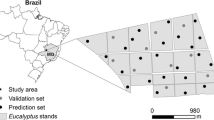Abstract
This paper explores the potential of machine learning in predicting Basal Area Increment (BAI) for the species Abies spectabilis, a commonly used metric for measuring tree growth. Machine learning algorithms are used to analyze environmental factors, biotic responses, growth, and their interactions to obtain accurate predictions of BAI under different climatic scenarios. The study aims to identify vulnerable tree at risk of dieback due to changes in climate or other environmental factors. The methodology includes data acquisition, preprocessing, feature selection, model development, and evaluation. The results reported in the study show M5’ performs better in predicting BAI than other machine learning models. The study’s findings can help in forest management and conservation decisions, such as selective harvesting, reforestation, carbon sequestration, and biodiversity conservation.
Access this chapter
Tax calculation will be finalised at checkout
Purchases are for personal use only
Similar content being viewed by others
References
Climate explorer. https://climexp.knmi.nl/start.cgi, (Accessed 10 May 2023)
World data service for paleoclimatology. https://www.ncei.noaa.gov/products/paleoclimatology/tree-ring, (Accessed 10 May 2023)
Bončina, A., Klopčič, M., Trifković, V., Ficko, A., Simončič, P.: Tree and stand growth differ among soil classes in semi-natural forests in central europe. CATENA 222, 106854 (2023)
Camarero, J.J., Gazol, A., Sangüesa-Barreda, G., Oliva, J., Vicente-Serrano, S.M.: To die or not to die: early warnings of tree dieback in response to a severe drought. J. Ecol. 103(1), 44–57 (2015)
Casas-Gómez, P., Sánchez-Salguero, R., Ribera, P., Linares, J.C.: Contrasting signals of the westerly index and north atlantic oscillation over the drought sensitivity of tree-ring chronologies from the mediterranean basin. Atmosphere 11(6) (2020)
Fu, L., et al.: A basal area increment-based approach of site productivity evaluation for multi-aged and mixed forests. Forests 8(4) (2017)
Hasenauer, H., Merkl, D., Weingartner, M.: Estimating tree mortality of norway spruce stands with neural networks. Adv. Environ. Res. 5(4), 405–414 (2001), international Symposium on Environmental Software Systems (ISESS 2000)
Jevšenak, J., Levanič, T.: Should artificial neural networks replace linear models in tree ring based climate reconstructions? Dendrochronologia 40, 102–109 (2016)
Jevšenak, J., Skudnik, M.: A random forest model for basal area increment predictions from national forest inventory data. For. Ecol. Manage. 479, 118601 (2021)
Liu, Z., Peng, C., Work, T., Candau, J.N., DesRochers, A., Kneeshaw, D.: Application of machine-learning methods in forest ecology: recent progress and future challenges. Environ. Rev. 26(4), 339–350 (2018). https://doi.org/10.1139/er-2018-0034
Miguel, E.P., et al.: Artificial intelligence tools in predicting the volume of trees within a forest stand. African J. Agricult. Res. 11(21), 1914–1923 (2016)
Navarro-Cerrillo, R.M., et al.: Is thinning an alternative when trees could die in response to drought? the case of planted pinus nigra and p. sylvestris stands in southern spain. For. Ecol. Manag. 433, 313–324 (2019)
Pretzsch, H.: The emergent past: past natural and human disturbances of trees can reduce their present resistance to drought stress. Euro. J. For. Res. 141, 87–104 (2022). https://link.springer.com/article/10.1007/s10342-021-01422-8
Vospernik, S.: Basal area increment models accounting for climate and mixture for austrian tree species. For. Ecol. Manage. 480, 118725 (2021)
Özçelık, R., Diamantopoulou, M.J., Eker, M., Gürlevık, N.: Artificial neural network models: An alternative approach for reliable aboveground pine tree biomass prediction. For. Sci. 63(3), 291–302 (2017). https://doi.org/10.5849/FS-16-006
Acknowledgements
The authors would like to thank the Spanish Ministry of Science and Innovation and the Junta de Andalucía for their support within the projects PID2020-117954RB-C21 and TED2021-131311B-C22, PY20-00870, UPO-138516, respectively. The authors would also like to thank the Fundación Tatiana Pérez de Guzmán el Buenofor the support offered through the Beca Predoctoral en Medioambiente de 2018.
Author information
Authors and Affiliations
Corresponding author
Editor information
Editors and Affiliations
Rights and permissions
Copyright information
© 2023 The Author(s), under exclusive license to Springer Nature Switzerland AG
About this paper
Cite this paper
Casas-Gómez, P., Martínez-Álvarez, F., Troncoso, A., Linares, J.C. (2023). Machine Learning Approaches for Predicting Tree Growth Trends Based on Basal Area Increment. In: García Bringas, P., et al. 18th International Conference on Soft Computing Models in Industrial and Environmental Applications (SOCO 2023). SOCO 2023. Lecture Notes in Networks and Systems, vol 749. Springer, Cham. https://doi.org/10.1007/978-3-031-42529-5_22
Download citation
DOI: https://doi.org/10.1007/978-3-031-42529-5_22
Published:
Publisher Name: Springer, Cham
Print ISBN: 978-3-031-42528-8
Online ISBN: 978-3-031-42529-5
eBook Packages: Intelligent Technologies and RoboticsIntelligent Technologies and Robotics (R0)




